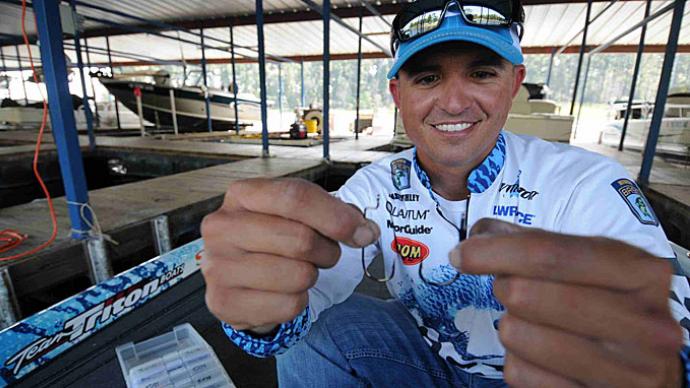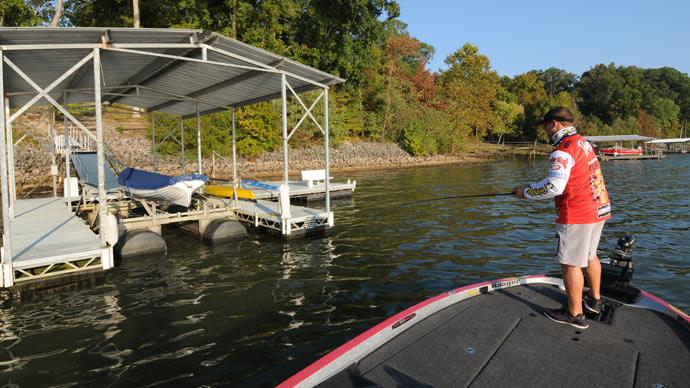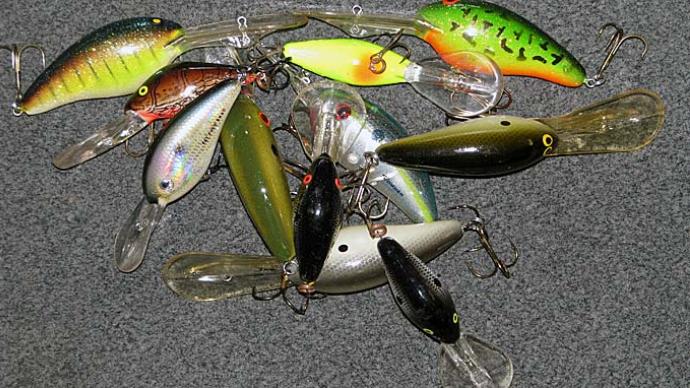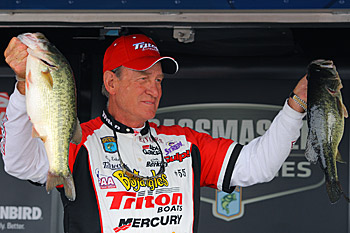
Guy Eaker has fished many places since he left his job as a supervisor for a North Carolina trucking company 41 years ago. He has spent time on the Bassmaster Elite Series. He’s still fishing the Bassmaster Opens. The amicable pro has appeared in more local tournaments than he can count.
Eaker has learned plenty of lessons and picked up many tricks for catching bass during that time. Kevin VanDam, the seven-time Bassmaster Angler of the Year and four-time Bassmaster Classic champion, helped drive home one in particular. It helped Eaker finish third at a Bassmaster Elite Series event on California’s Clear Lake in 2010 and has affected his fishing since.
VanDam gave Eaker a couple of sets of Mustad Triple Grip treble hooks, which he helped design before that tournament. Eaker put the hooks on a lipless crankbait to catch prespawn bass, which were waiting in submerged vegetation for conditions in the off-colored backwater to get right for spawning. He noticed a difference almost immediately.
Eaker could swing bass in the boat without worrying about the hooks pulling free. He could feel when they were about to jump next to the boat, and with help from his Stren braided line, he would lead them over the gunnel once they left the water. He caught 90 pounds and 11 ounces throughout the four-day event, not far behind winner Byron Velvick’s 98 pounds and 6 ounces.
Eaker still swaps stock trebles for Triple Grips seven years later. “I change them on many of my crankbaits and my jerkbaits,” he said. “It seems like my hookups are a lot better, and I quit losing a lot of fish.” Off the water, he usually holds court at The Great Outdoors, a tackle shop in his hometown, Cherryville, N.C. He said he had converted many customers to this treble hook brand. But he may have a second recommendation soon. He has started using Pure Fishing’s Fusion trebles and likes what he has seen so far.
Swapping stock trebles for sharper ones has been standard bass-fishing practice for many years. Today it’s done for reasons beyond improving hook quality. It can dial your lure into a specific situation and ensure your jerkbaits, crankbaits, spoons, topwaters and other treble-hooked lures put more bass in your boat.
Straight to the point
Hard-bodied baits have evolved over the years. Some include battery-powered technology such as lights and sounds. Others sport detailed paint jobs. And more are being equipped with high-quality hooks. Spro crankbaits, for example, come with Gamakatsu trebles, whose points are honed to sewing-pin sharpness.
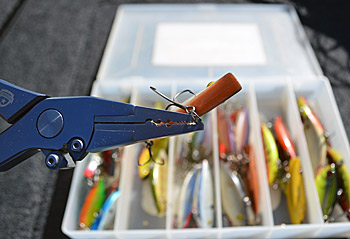
It doesn’t take a rocket scientist to understand why sharp hooks are essential. They grab bass, even those that slap or brush against a lure. They also drive deeper with less force. So if you don’t get the all-star hookset you wanted, sharp hooks will more often than not allow you to land that bass. That’s incredibly reassuring when the 4-pound smallmouth that blasted your topwater decides to set an altitude record on its first jump.
Many hard-bodied lures are sold with basic hooks. Those are the ones that you need to swap out.
There are a couple of characteristics to look for when determining hook quality. These don’t always hold, but they do often enough to point you in the right direction. The first is the hook’s appearance. Basic trebles are usually bronze or sport a dull metallic finish. Higher-quality ones have a polished surface such as black nickel. Don’t assume red-colored hooks are high-quality; that’s a popular finish. Set a point on your thumb’s nail. High-quality hooks need little pressure to stick and should leave a scratch when drawn across the nail. The point on high-quality trebles is either conical or sports cutting grooves such as those Eagle Claw makes on its Trokar hooks. Lower-quality hooks can have points that are slightly bent inwards.
The shape is one more characteristic to keep in mind when choosing replacement hooks. For example, round-bend trebles have a consistent gap from the bend to the point. Others, such as Triple Grips and Gamakatsu’s EWG trebles, have a gap that’s slightly narrower at the point compared to the bend. On the one hand, round bends have more room to hook bass. On the other, a gap reduction can hold bass better. Ultimately, the decision on shape comes down to personal preference, though it might be hard to argue with VanDam’s success.
Many basic treble hooks can be sharpened. Flat files work best. Work it across the top and sides, angling the tool slightly toward the point. You can make it razor-sharp, but you will need to stay after it to keep it that way. Bouncing off structure, cover, and the inside of bass’ mouths will dull it quickly.
Eaker says it takes too much time to sharpen treble hooks. So he picks out a new set of high-quality ones once replacements dull. That’s not a bad course of action because it’s next to impossible to recreate their level of sharpness with a file.
Change action
When the water turns cold on North Carolina’s Lake Norman, Eaker fishes a jerkbait. If you see him at a boat show, he’ll be more than happy to show the cellphone pictures of the giants he catches on it. He said what makes his lure special is its ability to run down about 5 feet and then sit motionless when he pauses the retrieve. That’s what triggers strikes, he said. But his jerkbait must strike a balance between buoyancy and weight to achieve that perfect suspension. That’s why he swaps its stock hooks for Triple Grips of the same size.
Sticking with replacement trebles the same size as the originals is the best way to preserve a hard-bodied lure’s action. Bigger or smaller ones change the lure’s weight, which changes how it swims or floats. Topwaters, for example, can sink if replacement hooks are too large. Or, in the case of Eaker’s jerkbait, a larger hook would cause it to sink rather than suspend.
It’s not only hooked size that affects a lure’s action. Manufacturers use different types and diameters of metal to create countless styles of hooks. That means a heavy-duty No. 1 treble hook, for example, weighs more than a light-wire version in the same size. In this case, you may need to adjust the replacement hooks’ size, testing the lure until you find one that allows it to run correctly.
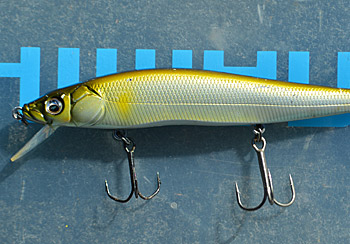
There are times when you may want replacement treble hooks to change a lure’s action. You may want it to float up faster if you are cranking it into brush or vegetation, and a rapid rise on the pause is generating reaction strikes. In that case, go with lighter hooks. Simply exchanging one treble hook for a size larger can cause a lure that wants to rise to suspend. You may need to change more as the water gets colder and denser. A lure that perfectly suspends in the coldest water will sink like a rock when it warms. If you like the hooks your lure has, you can still make it suspend by replacing the stock split rings with larger or heavier ones. As with changing hooks, it’s usually best to start with the one closest to a crankbait’s or jerkbait’s bill.
Hook more bass
Once you have selected new treble hooks, you need to attach them to the lure. While the process is straightforward, keep this information in mind.
We’ve all been there, using a spinnerbait blade or hook from a different lure to pry open a split ring. The latter method is an excellent way to end up hooked. So purchase a pair of quality split-ring pliers and keep them in your boat or tackle bag. Having a second set at the workbench is not a bad idea where you tune tackle between trips. They’ll make your life easier, and you’ll enjoy how fast you can change trebles with them.
Don’t worry about which side of the treble hook you insert the split ring. The hook will rotate so the lure will lie between two points. You want that, especially when casting around aquatic vegetation or brush.
Some lures have hooks that are attached without split rings. Adding them can help keep more bass hooked. That’s because the extra articulation lessens the leverage bass can generate with the lure against the hook, especially when jumping or thrashing along the surface. Adding them is a simple process. Cut the hook eye and remove the treble from the screw eye. Thread the split ring onto the screw eye, then thread on a new treble hook. You also can add split rings to lures that sport hook hangers, such as Zara Spooks. Remove the tiny screws that hold the hanger, thread it through the split ring and reattach. Add the new treble, and you’re ready to go fishing.
If you aren’t hooking bass slapping at your crankbait or topwater, take a tip from musky anglers. They routinely reshape their trebles, so two points are 180 degrees apart, so the treble looks like the letter T when viewed from the bottom. That brings those two points off the side of the lure instead of against it. It might not be an option when throwing square bills around logs, but anyone who has watched a bass repeatedly bats at their topwater lure without being hooked is ready to try this modification.


